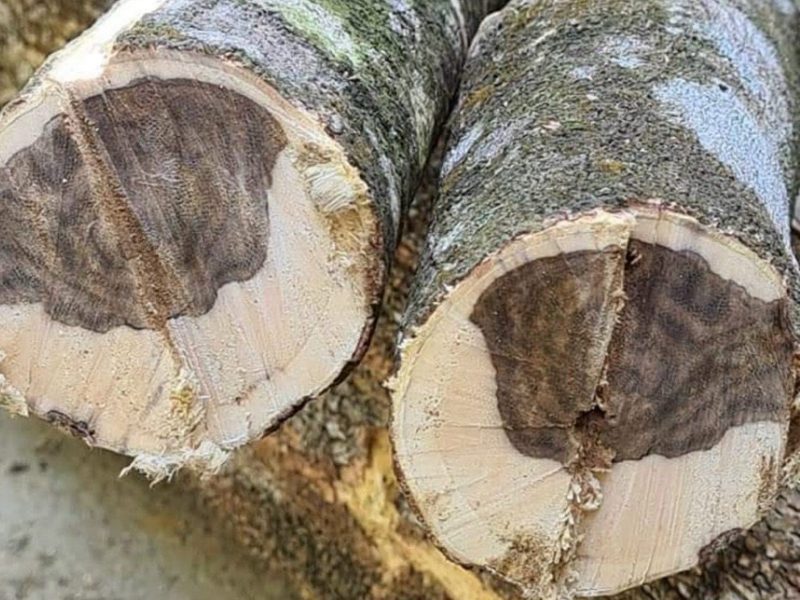
Introduction
Table of Contents
ToggleAgarwood is a highly valued resinous wood renowned for its rich fragrance and significant cultural importance. Originating from Southeast Asia, agarwood has been treasured for centuries in traditional medicine, perfumery, and spiritual practices. The scarcity of natural agarwood has driven extensive research and the development of innovations in agarwood cultivation to ensure sustainable agarwood production and meet global demand.
This section delves into the latest research on agarwood, innovations in agarwood cultivation, new applications of agarwood, and the role of agarwood biotechnology in transforming the industry. Before delving into the latest findings, it’s essential to understand what agarwood is and its significance.

Latest Research on Agarwood
Advances in Agarwood Identification and Quality Assessment
Recent latest research on agarwood has focused on improving agarwood identification and assessing its quality. Molecular techniques, such as DNA barcoding, have been employed to accurately identify agarwood species, ensuring authenticity and preventing adulteration. Additionally, non-destructive testing methods like infrared spectroscopy and X-ray fluorescence are being utilized to evaluate agarwood quality without damaging the precious wood.
These advancements are crucial for maintaining the integrity of agarwood products in the market. The research conducted on agarwood not only enhances our understanding but also informs practices like buying quality agarwood from reliable sources.
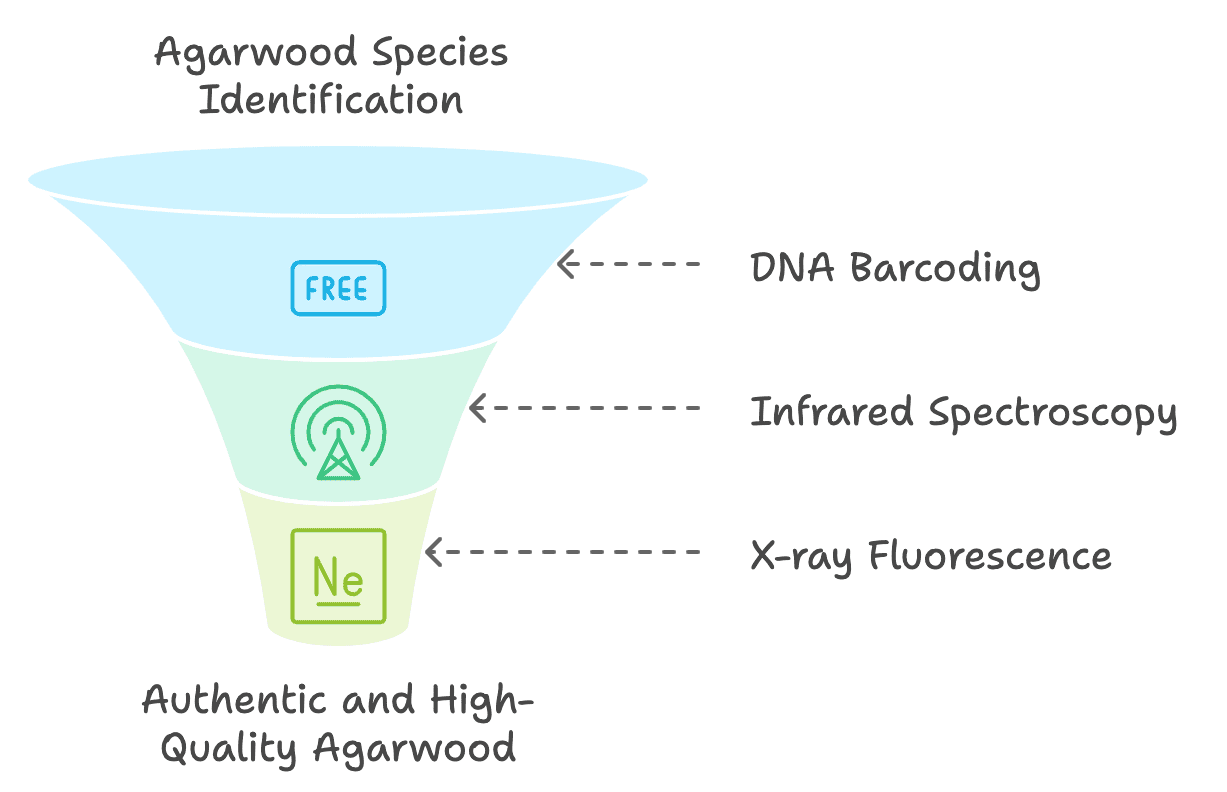
Understanding Agarwood Formation
A fundamental aspect of latest research on agarwood is understanding the biological mechanisms behind agarwood resin production. Studies have revealed that agarwood forms in response to wounds or infections caused by fungi, triggering the tree to produce resin as a defense mechanism.
Environmental factors, including climate, soil conditions, and biotic stressors, significantly influence resin development. Comprehensive research in this area aids in optimizing innovations in agarwood cultivation to enhance resin yield and quality.

Sustainable Harvesting Practices
Sustainability is a critical concern in the agarwood industry. Research on sustainable extraction methods focuses on minimizing the environmental impact of agarwood harvesting. Techniques such as regulated tapping and controlled harvesting cycles are being developed to ensure the long-term viability of agarwood ecosystems.
Additionally, studies on the impact of harvesting on agarwood populations help in formulating agarwood conservation strategies that balance commercial needs with ecological preservation.
Innovations in Agarwood Cultivation
Modern Cultivation Techniques
Innovations in agarwood cultivation are revolutionizing the way agarwood is produced. Hydroponic and aquaponic systems offer agarwood farmers alternative methods to grow trees in controlled environments, enhancing resin production and growth rates.
Controlled environment agriculture (CEA) applications, such as greenhouses with regulated temperature, humidity, and light, provide optimal conditions for agarwood trees, leading to higher quality resin and more consistent yields.
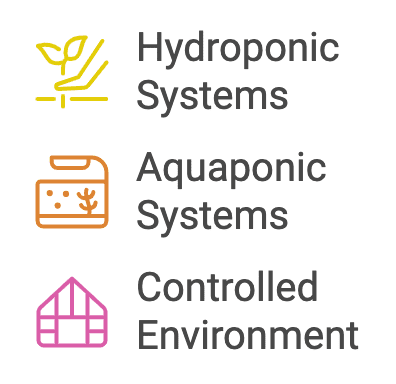
Genetic Improvement and Breeding Programs
Advancements in agarwood genetics and breeding programs are pivotal in developing high-yield agarwood trees. Selective breeding techniques aim to enhance traits such as resin production, growth rate, and disease resistance.
Furthermore, genetic engineering approaches are being explored to introduce desirable genes into agarwood trees, potentially increasing resin yield and improving overall tree health. These genetic advancements play a crucial role in ensuring a sustainable and productive agarwood cultivation industry.

Integrated Pest Management in Agarwood Plantations
Effective pest management is essential for maintaining healthy agarwood plantations. Integrated Pest Management (IPM) strategies combine sustainable pest control methods with the use of biological agents to manage agarwood pests.
Techniques such as biocontrol, where natural predators are introduced to control pest populations, reduce the reliance on chemical pesticides. Additionally, cultural practices like crop rotation and soil management contribute to minimizing pest infestations, promoting a healthier and more resilient agarwood ecosystem.
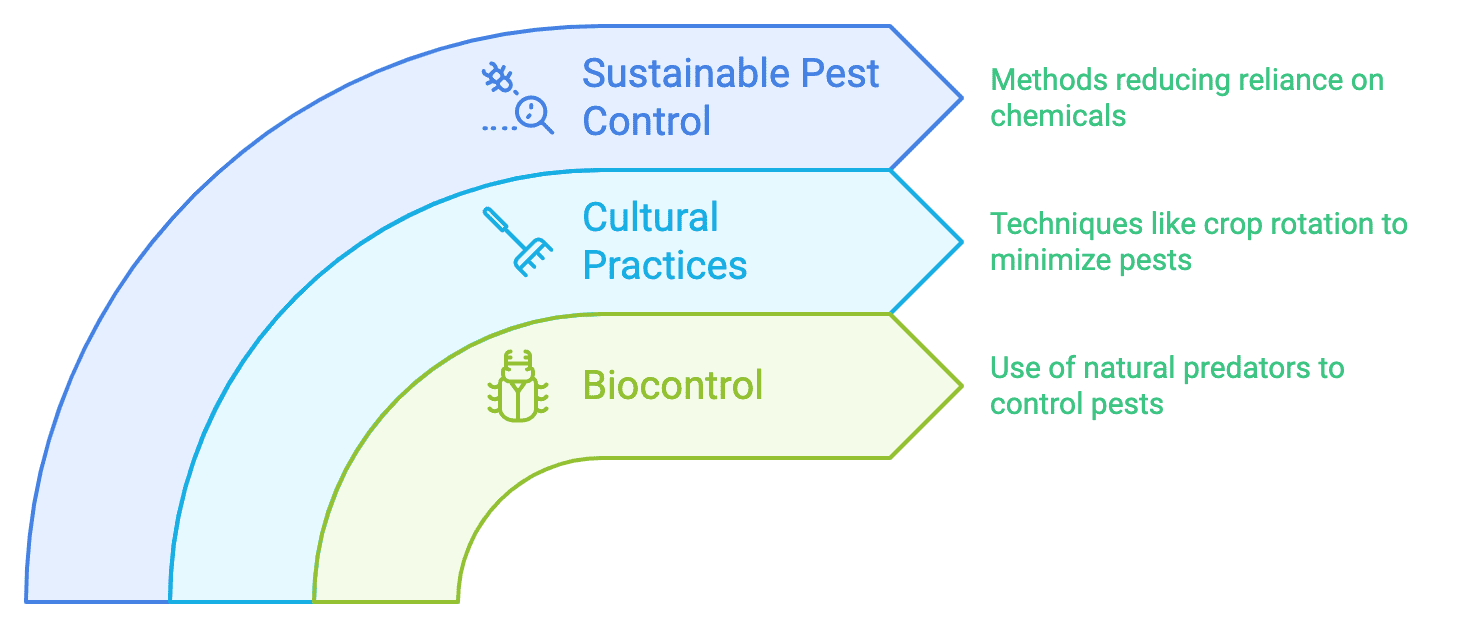
New Applications of Agarwood
Agarwood in Medicine and Pharmaceuticals
The therapeutic properties of agarwood have been recognized for centuries, and new applications of agarwood in medicine and pharmaceuticals are expanding its usage. Agarwood extracts are being studied for their anti-inflammatory, antioxidant, and antimicrobial properties, leading to the development of agarwood-based pharmaceuticals. These advancements not only enhance the medicinal value of agarwood but also open new avenues for its application in modern healthcare.

Agarwood in the Fragrance Industry
The fragrance industry highly values agarwood for its unique and enduring scent, making it a cornerstone of agarwood-based perfumes and scents. Innovations in the production process of oud oil involve creating synthetic analogs that mimic agarwood’s natural aroma, thereby making high-quality fragrances more accessible.
Additionally, current market trends show a growing consumer preference for natural and sustainably sourced fragrances, which drives the demand for authentic agarwood. These developments reinforce the fragrance industry’s reliance on agarwood as a key ingredient. Consequently, understanding the production process of oud oil is crucial for appreciating the ongoing innovations within the agarwood industry.

Agarwood in Traditional and Modern Practices
Beyond medicine and perfumery, agarwood plays a significant role in both traditional and modern practices. In aromatherapy, agarwood essential oil is used for its calming and therapeutic effects, integrating seamlessly into wellness routines.
Additionally, modern cultural practices incorporate agarwood in spiritual rituals, yoga, and meditation, blending traditional uses with contemporary lifestyles. These new applications highlight the versatility and enduring relevance of agarwood in today’s world.

Agarwood Biotechnology
Biotechnological Approaches to Agarwood Production
Agarwood biotechnology is at the forefront of enhancing agarwood production through innovative techniques. Tissue culture and micropropagation allow for the rapid multiplication of agarwood trees, ensuring a consistent supply for cultivation and research. In vitro induction of agarwood resin involves stimulating resin production in controlled environments, optimizing the conditions for maximum resin yield without harming the trees.
Genomic and Proteomic Studies in Agarwood
Understanding the genomic and proteomic aspects of agarwood is crucial for improving resin biosynthesis. Genome sequencing and gene expression analysis provide insights into the genetic factors that regulate resin production.
Proteomic profiling identifies the proteins involved in resin biosynthesis, enabling targeted biotechnological interventions to enhance resin yield and quality. These studies form the basis for genetic improvements and biotechnological advancements in the agarwood industry.
Biotechnology for Disease Resistance and Stress Tolerance
Biotechnological strategies are being developed to improve disease resistance and stress tolerance in agarwood trees. Genetic modifications aim to introduce genes that confer resistance to pathogens and enhance tolerance to environmental stresses such as drought and extreme temperatures.
These biotechnological advancements ensure that agarwood trees remain healthy and productive, even in challenging conditions, thereby supporting sustainable agarwood cultivation.

“For a broader perspective, refer to the comprehensive overview of the agarwood industry, which integrates various aspects of research, market trends, and expert insights.”
Future Perspectives and Challenges
Emerging Technologies in Agarwood Research
The future of latest research on agarwood is being shaped by emerging technologies such as artificial intelligence (AI) and machine learning. These technologies are being applied to predict resin yield, optimize cultivation conditions, and monitor tree health.
Additionally, the Internet of Things (IoT) is being integrated into agarwood cultivation to provide real-time data on environmental parameters, enabling precise management and decision-making. These technological innovations hold the promise of further enhancing agarwood production and quality.
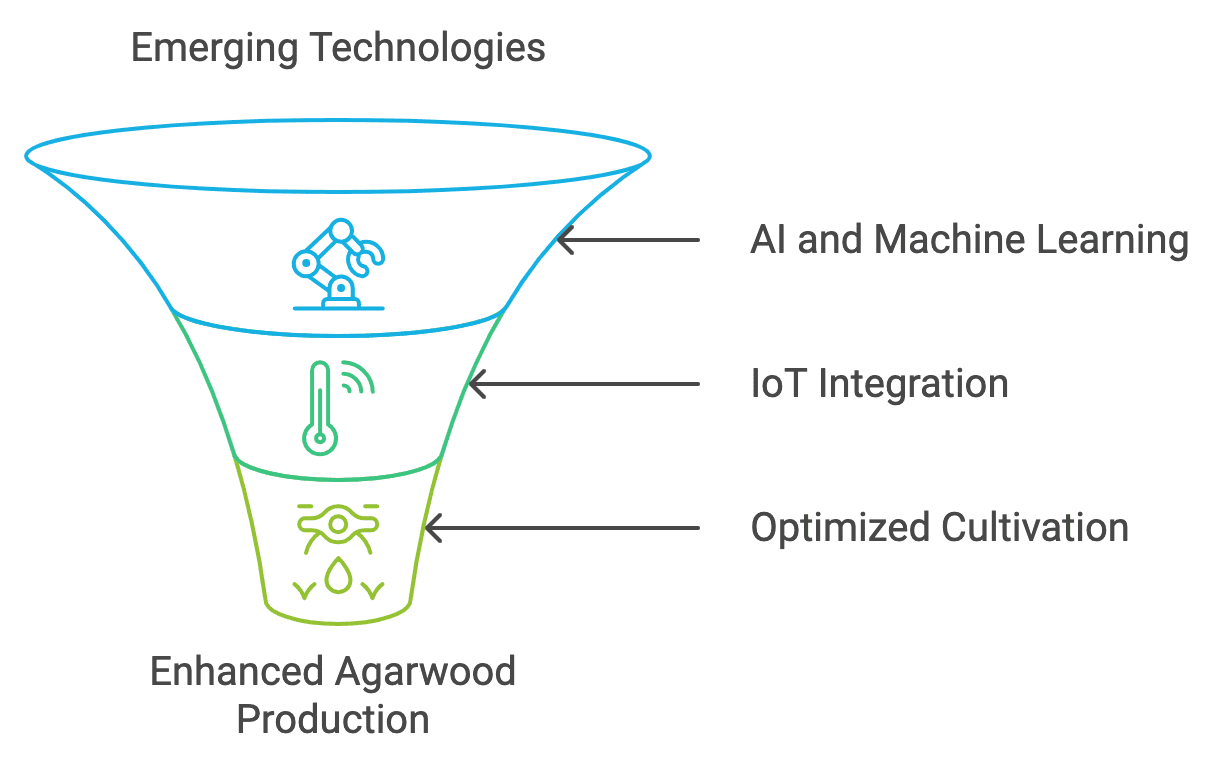
Addressing Sustainability and Conservation Issues
Balancing commercial production with conservation remains a significant challenge in the agarwood industry. Efforts to address sustainability include developing policy and regulatory frameworks that promote sustainable harvesting and cultivation practices.
Additionally, agarwood conservation strategies aim to protect agarwood ecosystems and ensure the long-term viability of agarwood resources. Addressing these sustainability issues is essential for maintaining the agarwood industry’s growth while preserving natural habitats. As the industry evolves, addressing the legal issues of agarwood trade is essential to ensure that technological advancements do not compromise sustainability.

Market Trends and Economic Implications
Agarwood market trends indicate a steady growth in the agarwood market, driven by increasing demand in fragrances, medicines, and wellness products. Future market forecasts predict a continued rise in agarwood prices due to its scarcity and high value.
Economic benefits of technological advancements in agarwood include increased production efficiency, reduced costs, and enhanced product quality. The latest research plays a vital role in differentiating real and fake agarwood, helping consumers make informed decisions in a market filled with imitations.
These economic implications highlight the importance of continued research and innovation in the agarwood sector. These market dynamics and trends directly influence the success strategies discussed in expert insights and success narratives.

Future of the Agarwood Market
Emerging Trends and Opportunities
The future of the agarwood market is promising, with several emerging trends creating new opportunities. Increased focus on sustainability and ethical sourcing presents opportunities for brands to differentiate themselves. Additionally, the integration of digital technologies in marketing and sales is expected to enhance consumer engagement and expand market reach.

Understanding these trends requires a look into the research and technological advancements shaping the industry and the success stories that exemplify effective strategies.
Challenges and Risks
Despite its growth, the agarwood market faces challenges such as sustainability concerns and market volatility. Overharvesting and illegal trading threaten natural agarwood resources, necessitating stringent conservation measures. Economic uncertainties and fluctuating prices also pose risks to market stability. Understanding agarwood price dynamics is crucial for anyone looking to navigate this growing market effectively.
Technological Advancements
Technological advancements are set to revolutionize the agarwood industry. Innovations in agarwood production techniques, such as biotechnology and genetic engineering, aim to increase resin yield and improve agarwood quality. Additionally, IoT and AI are being utilized to optimize agarwood cultivation and streamline supply chain management.
Strategic Recommendations
To capitalize on the future of the agarwood market, stakeholders should focus on sustainable practices and continuous product innovation. Investing in agarwood biotechnology and adopting advanced technological solutions can enhance production efficiency and product quality. Moreover, developing strong regulatory compliance frameworks will ensure long-term market sustainability and growth.
Conclusion
Research and new technology in agarwood have significantly advanced the understanding, cultivation, and application of this valuable resource. The latest research on agarwood has enhanced identification methods, understanding of resin formation, and sustainable harvesting practices. Innovations in agarwood cultivation, including modern cultivation techniques, agarwood genetics, and integrated pest management, have improved resin yield and tree health.
The new applications of agarwood in medicine, fragrance, and wellness demonstrate its versatility and enduring relevance. Agarwood biotechnology has opened new avenues for resin production and genetic improvements, ensuring the agarwood industry’s sustainability and growth.
The future of agarwood is promising, with emerging technologies like AI and IoT set to revolutionize cultivation and research. However, addressing sustainability and conservation challenges will be crucial for the industry’s long-term success. Market trends indicate a robust demand for agarwood, underscoring the economic importance of continued research and innovation.
In conclusion, the integration of latest research, innovations in agarwood cultivation, new applications, and agarwood biotechnology is shaping the future of agarwood, ensuring its preservation and enhancing its value in various industries. Continued research and sustainable practices are essential to harness the full potential of agarwood and secure its place in the global market.
FAQs
1. Why is agarwood so valuable, and what are its primary applications?
Agarwood is highly valued for its unique, rich fragrance and cultural significance. Traditionally used in perfumery, traditional medicine, and spiritual practices, agarwood is treasured for its therapeutic properties and enduring scent. Its scarcity and intricate formation process contribute to its premium status in the global market.
2. How is research advancing the identification and quality assessment of agarwood?
Recent research has introduced molecular techniques like DNA barcoding to verify agarwood species and prevent adulteration. Non-destructive testing methods, such as infrared spectroscopy, are used to assess agarwood quality without damaging the wood, ensuring authenticity and quality control across the market.
3. What innovations are being made in agarwood cultivation?
Innovations such as hydroponics, controlled environment agriculture (CEA), and genetic improvement programs have revolutionized agarwood cultivation. These techniques create optimal growing conditions, enhance resin yield, and improve tree resilience, making production more sustainable and efficient.
4. How is agarwood biotechnology contributing to the industry?
Agarwood biotechnology enables rapid tree multiplication through tissue culture and introduces genetic improvements for disease resistance and stress tolerance. Techniques like in vitro resin induction allow for high resin yield without harming trees, making production more sustainable and meeting increasing demand.
5. What role does sustainability play in the agarwood industry?
Sustainability is essential to preserving natural agarwood resources and balancing commercial demands with environmental preservation. Sustainable practices, including regulated tapping, controlled harvesting cycles, and biotechnological advancements, help protect agarwood ecosystems and ensure the industry’s long-term viability.
Author
Le Minh Tuan is the Marketing Director of Oudgo, where he leads the development of marketing strategies, brand promotion, and the expansion of consumer markets. He holds a degree in Communications from the Foreign Trade University and boasts over ten years of experience in marketing and brand management, having worked with several international companies prior to joining Oudgo.Mr. Tuan has spearheaded creative marketing campaigns that seamlessly blend traditional and modern approaches, significantly enhancing Oudgo’s brand recognition and growing its customer base. His innovative efforts have been pivotal in Oudgo receiving numerous awards for brand excellence and product quality. See more
